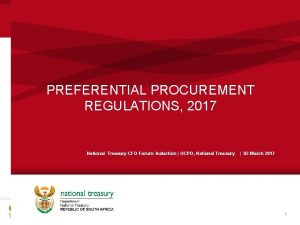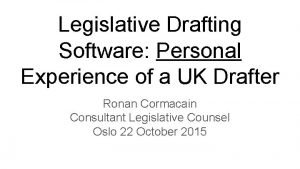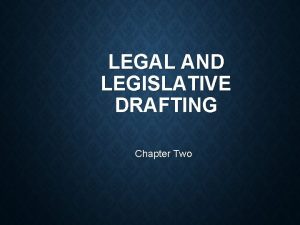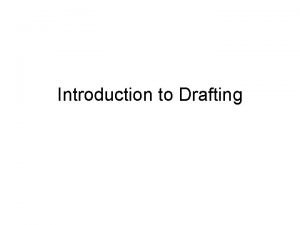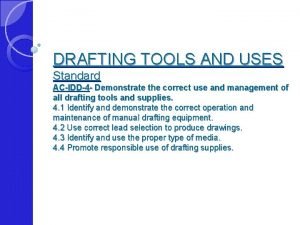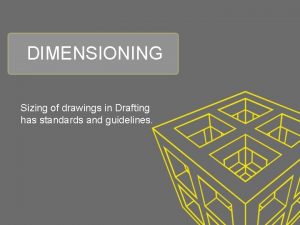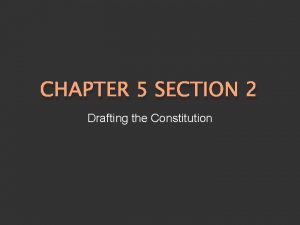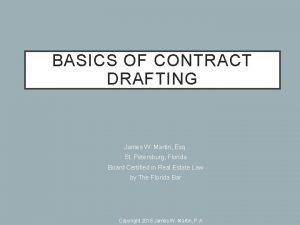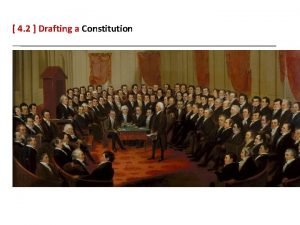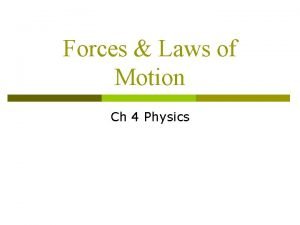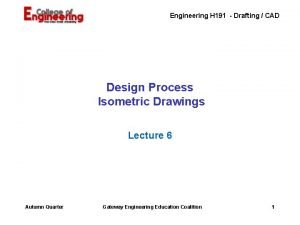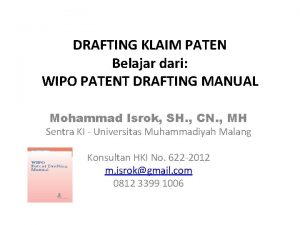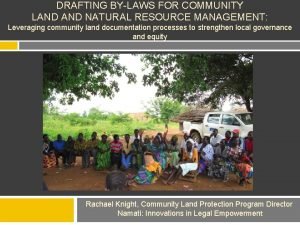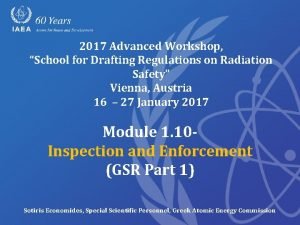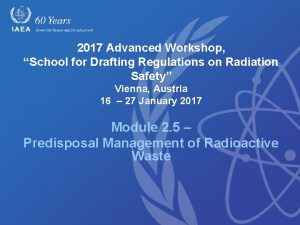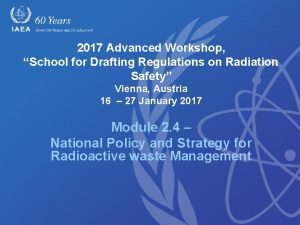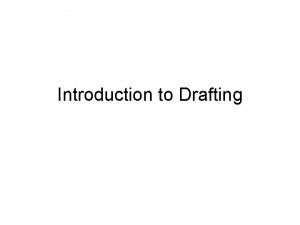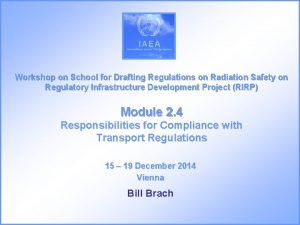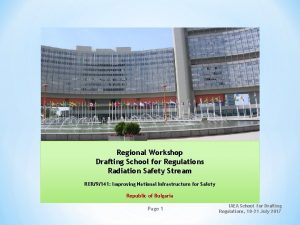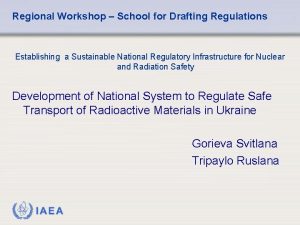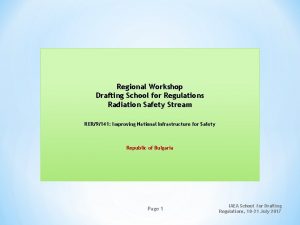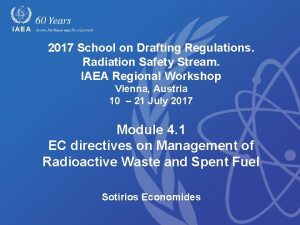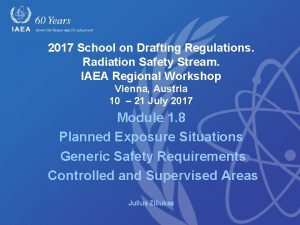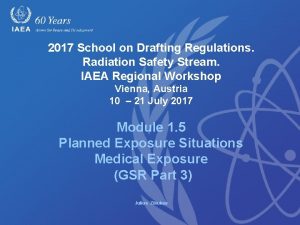2017 Advanced Workshop School for Drafting Regulations on




























































































- Slides: 92

2017 Advanced Workshop, “School for Drafting Regulations on Radiation Safety” Vienna, Austria 16 – 27 January 2017 Modules 1. 8 & 1. 9 Planned exposure situations Generic safety requirements (GSR Part 3) Sotiris Economides, Special Scientific Personnel, Greek Atomic Energy Commission

Contents 1. Planned exposure situation 2. Scope 3. Graded approach 4. Notification & authorization 5. Exemption & Clearance 6. Responsibilities of registrants and licensees in planned exposure situations 7. Justification of practices Occupational Exposure 8. Optimization of protection and safety 9. Safety assessment 10. Monitoring for verification of compliance 11. Prevention and mitigation of accidents 12. Investigations and feedback of information on operating experience 2

Contents 12. Investigations and feedback of information on operating experience 13. Radiation generators and radioactive sources 14. Human imaging using radiation for purposes other than medical diagnosis, medical treatment or biomedical research 3

Planned Exposure Situation • A planned exposure situation is a situation of exposure that arises from the planned operation of a source or from a planned activity that results in an exposure due to a source. • The primary means of controlling exposure in planned exposure situations is: - by good design of facilities, equipment and operating procedures, and - by training. 4

Planned Exposure Situation Attention! In planned exposure situations, exposure at some level can be expected to occur. If exposure is not expected to occur with certainty, but could result from an accident or from an event or a sequence of events that may occur but is not certain to occur, this is referred to as ‘potential exposure’. 5

Planned Exposure Situation • For planned exposure situations, exposures and risks are subject to control to ensure that the specified dose limits for occupational exposure and those for public exposure are not exceeded, and optimization is applied to attain the desired level of protection and safety. 6

Scope The production, supply, provision and transport of radioactive material and of devices that contain radioactive material The production and supply of devices that generate radiation, The generation of nuclear power The use of radiation or radioactive material for medical, industrial, veterinary, agricultural, legal or security purposes The use of radiation or radioactive material for education, training or research The mining and processing of raw materials that involve exposure due to radioactive material; Any other practice as specified by the regulatory body. 7

Scope • The requirements for planned exposure situations apply to exposure due to sources within practices, as follows: a. Facilities that contain radioactive material and facilities that contain radiation generators, including: - nuclear installations, - medical radiation facilities, - veterinary radiation facilities, - facilities for the management of radioactive waste, - installations for the processing of radioactive material, - irradiation facilities, and - mineral extraction and mineral processing facilities that involve or could involve exposure to radiation or exposure due to radioactive material; 8

Scope o a sterilization gamma irradiation unit is a source for the practice of radiation preservation of food. o an X ray unit may be a source for the practice of radiodiagnosis. o a nuclear power plant is part of the practice of generating electricity by nuclear fission, and may be regarded as a single source (e. g. with respect to discharges) or as a collection of sources (e. g. for purposes of occupational radiation protection). complex or multiple installation situated at one location o a site may, as appropriate, be considered a single source for the purposes of application of these Standards. 9

Scope • The requirements for planned exposure situations apply to exposure due to sources within practices, as follows: b. Individual sources of radiation, including sources within the types of facility mentioned previously as appropriate, in accordance with the requirements of the regulatory body. 10

Scope • The requirements for planned exposure situations apply to exposure due to sources within practices, as follows: b. Individual sources of radiation, including sources within the types of facility mentioned previously as appropriate, in accordance with the requirements of the regulatory body. Attention! The requirements for planned exposure situations apply for any occupational exposure, medical exposure or public exposure due to any practice or due to a source within a practice as specified above. 11

Scope Attention! • Exposure due to natural sources is, in general, considered an existing exposure situation. However, the relevant requirements for planned exposure situations apply to: a. Exposure due to material(2) in any practice specified above where the activity concentration in the material of any radionuclide in the uranium decay chain or the thorium decay chain is greater than 1 Bq/g or the activity concentration of 40 K is greater than 10 Bq/g; (2) A situation of exposure due to radionuclides of natural origin in food, feed, drinking water, agricultural fertilizer and soil amendments, construction materials and residual radioactive material in the environment is treated as an existing exposure situation regardless of the activity concentrations of the radionuclides concerned. 12

Scope Attention! • Exposure due to natural sources is, in general, considered an existing exposure situation. However, the relevant requirements for planned exposure situations apply to: a. Exposure due to material(2) in any practice specified above where the activity concentration in the material of any radionuclide in the uranium decay chain or the thorium decay chain is greater than 1 Bq/g or the activity concentration of 40 K is greater than 10 Bq/g; b. Public exposure due to discharges or due to the management of radioactive waste arising from a practice involving material as specified in (a) above; 13

Scope Attention! • Exposure due to natural sources is, in general, considered an existing exposure situation. However, the relevant requirements for planned exposure situations apply to: c. Exposure due to 222 Rn and to 222 Rn progeny and due to 220 Rn and to 220 Rn progeny in workplaces in which occupational exposure due to other radionuclides in the uranium decay chain or the thorium decay chain is controlled as a planned exposure situation; d. Exposure due to 222 Rn and to 222 Rn progeny where the annual average activity concentration of 222 Rn in air in workplaces remains above the reference level established in accordance with the relative requirements of these Standards. 14

GENERIC REQUIREMENTS 15

“No person or organization shall adopt, introduce, conduct, discontinue or cease a practice, or shall, as applicable, mine, extract, process, design, manufacture, construct, assemble, install, acquire, import, export, supply, provide, distribute, loan, hire, receive, site, locate, commission, possess, use, operate, maintain, repair, transfer, decommission, disassemble, transport, store or dispose of a source within a practice other than in accordance with the requirements of these Standards”. 16

Requirement 6: Graded Approach “The application of the requirements of these Standards in planned exposure situations shall be commensurate with the characteristics of the practice or the source within a practice, and with the likelihood and magnitude of exposures”. 17

Requirement 6: Graded Approach “The application of the requirements of these Standards in planned exposure situations shall be commensurate with the characteristics of the practice or the source within a practice, and with the likelihood and magnitude of exposures”. • The application of the requirements of these Standards shall: - be in accordance with the graded approach and - conform to any requirements specified by the regulatory body. Attention! Not all the requirements of these Standards are relevant for every practice or source, or for all the actions specified previously. 18

Requirement 7: Notification & authorization “Any person or organization intending to operate a facility or to conduct an activity shall submit to the regulatory body a notification and, as appropriate, an application for authorization”. 19

Requirement 7: Notification & authorisation Notification • Any person or organization intending to carry out any of the actions specified shall submit a notification to the regulatory body of such an intention. • Notification alone is sufficient provided that the exposures expected to be associated with the practice or action are unlikely to exceed a small fraction, as specified by the regulatory body, of the relevant limits, and that the likelihood and magnitude of potential exposures and any other potential detrimental consequences are negligible. Attention! Notification is required for consumer products only with respect to manufacture, maintenance, import, export, provision, distribution and, in some cases, disposal. 20

Requirement 7: Notification & authorisation Authorization: Registration or Licensing • Any person or organization intending to carry out any of the actions specified earlier, shall, unless notification alone is sufficient, apply to the regulatory body for authorization, which shall take the form of either registration or licensing. 21

Requirement 7: Notification & authorisation Authorization: Registration or Licensing • Any person or organization applying for authorization: a. Shall submit to the regulatory body the relevant information necessary to support the application; b. Shall refrain from carrying out any of the actions specified earlier until the registration or the license has been issued; c. Shall assess the nature, likelihood and magnitude of the expected exposures due to the source and shall take all necessary measures for protection and safety; 22

Requirement 7: Notification & authorisation Authorization: Registration or Licensing • Any person or organization applying for authorization: d. Shall, if there is a possibility for an exposure to be greater than a level as specified by the regulatory body, have a safety assessment made and submitted to the regulatory body as part of the application; e. Shall, as required by the regulatory body, have an appropriate prospective assessment made for radiological environmental impacts, commensurate with the radiation risks associated with the facility or activity. 23

Requirement 8: Exemption & Clearance “The government or the regulatory body shall determine which practices or sources within practices are to be exempted from some or all of the requirements of these Standards. The regulatory body shall approve which sources, including materials and objects, within notified practices or authorized practices may be cleared from regulatory control”. 24

Requirement 8: Exemption & Clearance Exemption • The government or the regulatory body shall determine which practices or sources within practices are to be exempted from some or all of the requirements of these Standards, including the requirements for notification, registration or licensing, using as the basis for this determination the criteria for exemption specified in Schedule I or any exemption levels specified by the regulatory body on the basis of these criteria. Attention! Exemption shall not be granted for practices deemed to be not justified. 25

Requirement 8: Exemption & Clearance Exemption • The government or the regulatory body shall determine which practices or sources within practices are to be exempted from some or all of the requirements of these Standards, including the requirements for notification, registration or licensing, using as the basis for this determination the criteria for exemption specified in Schedule I or any exemption levels specified by the regulatory body on the basis of these criteria. Attention! Exemption shall not be granted for practices deemed to be not justified. 26

Requirement 8: Exemption & Clearance • The regulatory body shall approve which sources, including materials and objects, within notified or authorized practices may be cleared from regulatory control, using as the basis for such approval the criteria for clearance specified in Schedule I or any clearance levels specified by the regulatory body on the basis of these criteria. Attention! By means of this approval, the regulatory body shall ensure that sources that have been cleared from regulatory control do not again become subject to the requirements for notification, registration or licensing unless it so specifies. 27

Requirement 9: Responsibilities of registrants and licensees in planned exposure situations “Registrants and licensees shall be responsible for protection and safety in planned exposure situations”. 28

Requirement 9: Responsibilities of registrants and licensees in planned exposure situations “Registrants and licensees shall be responsible for protection and safety in planned exposure situations”. • Registrants and licensees: - shall bear the responsibility for setting up and implementing the technical and organizational measures that are necessary for protection and safety for the practices and sources for which they are authorized. - may designate suitably qualified persons to carry out tasks relating to these responsibilities, but they shall retain the prime responsibility for protection and safety. - shall document the names and responsibilities of persons designated to ensure compliance with the requirements of these Standards. 29

Requirement 9: Responsibilities of registrants and licensees in planned exposure situations “Registrants and licensees shall be responsible for protection and safety in planned exposure situations”. Attention ! Registrants and licensees shall notify the regulatory body of any intention to introduce modifications to any practice or source for which they are authorized, whenever the modifications could have significant implications for protection and safety, and they shall not carry out any such modification unless it is specifically authorized by the regulatory body. 30

Requirement 9: Responsibilities of registrants and licensees in planned exposure situations • Registrants and licensees: a. Shall establish clear lines of responsibility and accountability for protection and safety for the sources for which they are authorized, and shall establish organizational arrangements for protection and safety; b. Shall ensure that any delegation of responsibilities by a principal party is documented; c. Shall, for the sources for which they are authorized and for which a safety assessment is required(1), conduct such a safety assessment and keep it up to date in accordance with the requirement for additional reviews of the safety assessment as necessary ; (1) Exposure greater than a level defined by the regulatory body 31

Requirement 9: Responsibilities of registrants and licensees in planned exposure situations • Registrants and licensees: d. Shall, for the sources for which they are authorized and for which the regulatory body requires a prospective assessment to be made for radiological environmental impacts, conduct such an assessment and keep it up to date; e. Shall assess the likelihood and magnitude of potential exposures, their likely consequences and the number of individuals who may be affected by them; f. Shall have in place operating procedures and arrangements for protection and safety that are subject to periodic review and updating under a management system; 32

Requirement 9: Responsibilities of registrants and licensees in planned exposure situations • Registrants and licensees: g. Shall establish procedures for reporting on and learning from accidents and other incidents; h. Shall establish arrangements for the periodic review of the overall effectiveness of the measures for protection and safety; i. Shall ensure that adequate maintenance, testing and servicing are carried out as necessary so that sources remain capable of fulfilling their design requirements for protection and safety throughout their lifetime; j. Shall ensure safe management of and control over all radioactive waste that is generated, and shall dispose of such waste in accordance with the regulatory requirements. 33

Requirement 10: Justification of practices “The government or the regulatory body shall ensure that only justified practices are authorized”. 34

Requirement 10: Justification of practices “The government or the regulatory body shall ensure that only justified practices are authorized”. • The government or the regulatory body, as appropriate, shall ensure: -that provision is made for the justification of any type of practice and for review of the justification, as necessary, and -that only justified practices are authorized. 35

Requirement 10: Justification of practices • The following practices are deemed to be not justified: a. Practices, except for justified practices involving medical exposure, that result in an increase in activity, by the deliberate addition of radioactive substances or by activation, in food, feed, beverages, cosmetics or any other commodity or product intended for ingestion, inhalation or percutaneous intake by, or application to, a person; b. Practices involving the frivolous use of radiation or radioactive substances in commodities or in consumer products as toys and personal jewellery or adornments, which result in an increase in activity, by the deliberate addition of radioactive substances or by activation (4); c. Human imaging using radiation that is performed as a form of art or for publicity purposes. 36

Requirement 10: Justification of practices • Human imaging using radiation that is performed for occupational, legal or health insurance purposes (5), and is undertaken without reference to clinical indication, shall normally be deemed to be not justified. (5) Such purposes for performing human imaging using radiation include: -assessment of fitness for employment (prior to employment or periodically during employment); -assessment of physiological suitability for a career or a sport; -assessment of athletes before a selection or transfer; -determination of age for legal purposes; obtaining evidence for legal purposes; detection of drugs concealed within the body; -immigration or emigration requirements; -pre-insurance checks; -and obtaining evidence for the purposes of a compensation claim. 37

Requirement 10: Justification of practices • Human imaging using radiation that is performed for occupational, legal or health insurance purposes (5), and is undertaken without reference to clinical indication, shall normally be deemed to be not justified. Attention! If, in exceptional circumstances, the government or the regulatory body decides that the justification of such human imaging for specific practices is to be considered, the relative requirements of the Standards shall apply. 38

Requirement 10: Justification of practices • Human imaging using radiation for theft detection purposes shall be deemed to be not justified. • Human imaging using radiation for the detection of concealed objects for anti-smuggling purposes shall normally be deemed to be not justified. Attention! If, in exceptional circumstances, the government or the regulatory body decides that the justification of such human imaging is to be considered, the relative requirements of the Standards shall apply. 39

Requirement 10: Justification of practices • Human imaging using radiation for the detection of concealed objects that can be used for criminal acts that pose a national security threat shall be justified only by the government. Attention! If the government decides that the justification of such human imaging is to be considered, the relative requirements of the Standards shall apply. 40

Requirement 11: Optimization of protection and safety “The government or the regulatory body shall establish and enforce requirements for the optimization of protection and safety, and registrants and licensees shall ensure that protection and safety is optimized”. 41

Requirement 11: Optimization of protection and safety • The government or the regulatory body: a. Shall establish and enforce requirements for the optimization of protection and safety; b. Shall require documentation addressing the optimization of protection and safety; c. Shall establish or approve constraints on dose and on risk, as appropriate, or shall establish or approve a process for establishing such constraints, to be used in the optimization of protection and safety. 42

Requirement 11: Optimization of protection and safety Attention! For occupational exposure, the relevant dose constraint is on individual doses to workers, established and used by registrants and licensees to set the range of options in optimizing protection and safety for the source. For public exposure, the relevant dose constraint is a source related value established or approved by the government or the regulatory body, with account taken of the doses from planned operations of all sources under control. The dose constraint for each particular source is intended, among other things, to ensure that the sum of doses from planned operations for all sources under control remains within the dose limit. 43

Requirement 11: Optimization of protection and safety • Registrants and licensees shall ensure that protection and safety is optimized. • For occupational exposure and public exposure, registrants and licensees shall ensure, as appropriate, that relevant constraints are used in the optimization of protection and safety for any particular source within a practice. 44

Requirement 11: Optimization of protection and safety • For occupational exposure and public exposure, registrants and licensees shall ensure that all relevant factors are taken into account in a coherent way in the optimization of protection and safety to contribute to achieving the following objectives: a. To determine measures for protection and safety that are optimized for the prevailing circumstances, with account taken of the available options for protection and safety as well as the nature, likelihood and magnitude of exposures; b. To establish criteria, on the basis of the results of the optimization, for the restriction of the likelihood and magnitudes of exposures by means of measures for preventing accidents and for mitigating the consequences of those that do occur. 45

Requirement 12: Dose limits “The government or the regulatory body shall establish dose limits for occupational exposure and public exposure, and registrants and licensees shall apply these limits”. 46

Requirement 12: Dose limits • The government or the regulatory body shall establish and the regulatory body shall enforce compliance with the dose limits specified in Schedule III for occupational exposures and public exposures in planned exposure situations. 47

Requirement 12: Dose limits • The government or the regulatory body shall determine what additional restrictions, if any, are required to be complied with by registrants and licensees to ensure that the dose limits specified in Schedule III are not exceeded owing to possible combinations of doses from exposures due to different authorized practices. • Registrants and licensees shall ensure that the exposures of individuals due to the practices for which the registrants and licensees are authorized are restricted, so that neither the effective dose nor the equivalent dose to tissues or organs exceeds any relevant dose limit specified in Schedule III. 48

Requirement 13: Safety assessment “The regulatory body shall establish and enforce requirements for safety assessment, and the person or organization responsible for a facility or activity that gives rise to radiation risks shall conduct an appropriate safety assessment of this facility or activity”. 49

Requirement 13: Safety assessment • The regulatory body shall establish requirements for persons or organizations responsible for facilities and activities that give rise to radiation risks to conduct an appropriate safety assessment(1). • Prior to the granting of an authorization, the responsible person or organization shall be required to submit a safety assessment, which shall be reviewed and assessed by the regulatory body. (1) Requirements on safety assessment for facilities and activities are established in: INTERNATIONAL ATOMIC ENERGY AGENCY, Safety Assessment for Facilities and Activities, IAEA Safety Standards Series No. GSR Part 4, IAEA, Vienna (2009) 50

Requirement 13: Safety assessment • The person or organization, as required or registrants and licensees, as appropriate, shall conduct a safety assessment that is either generic or specific to the practice or source for which they are responsible. (2) A generic safety assessment is usually sufficient for types of source with a high degree of uniformity in design. A specific safety assessment is usually required in other cases; however, the specific safety assessment need not include those aspects covered by a generic safety assessment, if a generic safety assessment has been conducted for the type of source. 51

Requirement 13: Safety assessment • Safety assessments shall be conducted at different stages, including: - siting, -design, -manufacture, -construction, -assembly, -commissioning, -operation, -maintenance and -decommissioning (or closure) of facilities or parts thereof. 52

Requirement 13: Safety assessment • The safety assessment shall include, as appropriate, a systematic critical review of: a. The operational limits and conditions for the operation of the facility; b. The ways in which structures, systems and components, including software, and procedures relating to protection and safety might fail, singly or in combination, or might otherwise give rise to exposures, and the consequences of such events; c. The ways in which external factors could affect protection and safety; d. The ways in which operating procedures relating to protection and safety might be erroneous, and the consequences of such errors; 53

Requirement 13: Safety assessment • The safety assessment shall include, as appropriate, a systematic critical review of: e. The implications for protection and safety of any modifications; f. The implications for protection and safety of security measures or of any modifications to security measures; g. Any uncertainties or assumptions and their implications for protection and safety. 54

Requirement 13: Safety assessment • The registrant or licensee shall take into account in the safety assessment: a. Factors that could give rise to a substantial release of radioactive material, the measures available to prevent or to control such a release, and the maximum activity of radioactive material that, in the event of a major failure of the containment, could be released to the environment; b. Factors that could give rise to a smaller but continuing release of radioactive material, and the measures available to detect and to prevent or to control such a release; 55

Requirement 13: Safety assessment • The registrant or licensee shall take into account in the safety assessment: c. Factors that could give rise to unintended operation of any radiation generator or a loss of shielding, and the measures available to detect and to prevent or to control such occurrences; d. The extent to which the use of redundant and diverse safety features that are independent of each other, so that failure of one does not result in failure of any other, is appropriate to restrict the likelihood and magnitude of potential exposures. Attention! Registrants and licensees shall ensure that the safety assessment is documented and, where appropriate, that it is independently reviewed under the relevant management system. 56

Requirement 13: Safety assessment • Registrants and licensees shall perform additional reviews of the safety assessment as necessary to ensure that the technical specifications or conditions of use continue to be met when: a. Significant modifications to the facility or to its operating procedures or maintenance procedures are envisaged; b. Significant changes occur on the site that could affect the safety of the facility or of activities on the site; c. Information on operating experience, or information about accidents and other incidents that could result in exposures, indicates that the current assessment might be invalid; d. Any significant changes in activities are envisaged; e. Any relevant changes in guidelines or standards have been made or are envisaged. 57

Requirement 13: Safety assessment Attention! - If as a result of a safety assessment, or for any other reason, opportunities to improve protection and safety appear to be available and improvement seems desirable, any consequential modifications shall be made cautiously and only after favorable assessment of all the implications for protection and safety. - The implementation of all improvements shall be prioritized so as to optimize protection and safety. 58

Requirement 14: Monitoring for verification of compliance “Registrants and licensees and employers shall conduct monitoring to verify compliance with the requirements for protection and safety”. 59

Requirement 14: Monitoring for verification of compliance “Registrants and licensees and employers shall conduct monitoring to verify compliance with the requirements for protection and safety”. • The regulatory body shall establish requirements that monitoring and measurements be performed to verify compliance with the requirements for protection and safety. • The regulatory body shall be responsible for review and approval of the monitoring and measurement programmes of registrants and licensees. 60

Requirement 14: Monitoring for verification of compliance • Registrants and licensees and employers shall ensure that: a. Monitoring and measurements of parameters are performed as necessary for verification of compliance with the requirements of these Standards; b. Suitable equipment is provided and procedures for verification are implemented; c. Equipment is properly maintained, tested and calibrated at appropriate intervals with reference to standards traceable to national or international standards; d. Records are maintained of the results of monitoring and verification of compliance, as required by the regulatory body, including records of the tests and calibrations carried out in accordance with these Standards; e. The results of monitoring and verification of compliance are shared with the regulatory body as required. 61

Requirement 15: Prevention and mitigation of accidents “Registrants and licensees shall apply good engineering practice and shall take all practicable measures to prevent accidents and to mitigate the consequences of those accidents that do occur”. 62

Requirement 15: Prevention and mitigation of accidents Good engineering practice • The registrant or licensee, in cooperation with other responsible parties, shall ensure that the siting, location, design, manufacture, construction, assembly, commissioning, operation, maintenance and decommissioning (or closure) of facilities or parts thereof are based on good engineering practice which shall, as appropriate: a. Take account of international and national standards; b. Be supported by managerial and organizational features, with the purpose of ensuring protection and safety throughout the lifetime of the facility; 63

Requirement 15: Prevention and mitigation of accidents Good engineering practice • The registrant or licensee, in cooperation with other responsible parties, shall ensure that the siting, location, design, manufacture, construction, assembly, commissioning, operation, maintenance and decommissioning (or closure) of facilities or parts thereof are based on good engineering practice which shall, as appropriate: c. Include adequate safety margins in the design and construction of the facility, and in operations involving the facility, so as to ensure reliable performance in normal operation, and take account of the necessary quality, redundancy and capability for inspection, with emphasis on preventing accidents, mitigating the consequences of those accidents that do occur and restricting any possible future exposures; 64

Requirement 15: Prevention and mitigation of accidents Good engineering practice • The registrant or licensee, in cooperation with other responsible parties, shall ensure that the siting, location, design, manufacture, construction, assembly, commissioning, operation, maintenance and decommissioning (or closure) of facilities or parts thereof are based on good engineering practice which shall, as appropriate: d. Take account of relevant developments concerning technical criteria, as well as the results of any relevant research on protection and safety and feedback of information on lessons learned from experience. 65

Requirement 15: Prevention and mitigation of accidents Defense in depth • Registrants and licensees shall ensure that a multilevel (defense in depth) system of sequential, independent provisions for protection and safety that is commensurate with the likelihood and magnitude of potential exposures is applied to sources for which the registrants and licensees are authorized. • Such defense in depth shall be applied for the purposes of: a. Preventing accidents; b. Mitigating the consequences of any accidents that do occur; c. Restoring the sources to safe conditions after any such accidents. 66

Requirement 15: Prevention and mitigation of accidents Accident prevention • Registrants and licensees shall ensure that structures, systems and components, including software, that are related to protection and safety for facilities and activities are designed, constructed, commissioned, operated and maintained so as to prevent accidents as far as reasonably practicable. 67

Requirement 15: Prevention and mitigation of accidents Accident prevention • The registrant or licensee for any facility or activity shall make suitable arrangements, such as a. To prevent reasonably foreseeable accidents in the facility or the activity; b. To mitigate the consequences of those accidents that do occur; c. To provide workers with the information, instruction, training and equipment necessary to restrict potential exposures; d. To ensure that there adequate procedures for the control of the facility and for the management of any reasonably foreseeable accidents; 68

Requirement 15: Prevention and mitigation of accidents Emergency preparedness and response • If the safety assessment indicates that there is a reasonable likelihood of an emergency affecting either workers or members of the public, the registrant or licensee shall prepare an emergency plan for the protection of people and the environment. • As part of this emergency plan, the registrant or licensee shall include arrangements for the prompt identification of an emergency, and for determining the appropriate level of the emergency response. 69

Requirement 15: Prevention and mitigation of accidents Emergency preparedness and response • In relation to the arrangements for the emergency response at the scene by the registrant or licensee, the emergency plan shall include, in particular: a. Provision for individual monitoring and area monitoring, and arrangements for medical treatment; b. Arrangements for assessing and mitigating any consequences of an emergency. 70

Requirement 15: Prevention and mitigation of accidents Emergency preparedness and response • Registrants and licensees shall be responsible for the implementation of their emergency plans and shall be prepared to take any necessary action for effective response. • To prevent the occurrence of conditions that could lead to a loss of control over a source or to the escalation of such conditions, registrants and licensees shall, as appropriate: a. Develop, maintain and implement procedures to provide the means for preventing loss of control over the source and for regaining control over the source as necessary; b. Make available equipment, instrumentation and diagnostic aids that may be needed; c. Train and periodically retrain personnel in the procedures to be followed and exercise the procedures. 71

Requirement 16: Investigations and feedback of information on operating experience “Registrants and licensees shall conduct formal investigations of abnormal conditions arising in the operation of facilities or the conduct of activities, and shall disseminate information that is significant for protection and safety”. 72

Requirement 16: Investigations and feedback of information on operating experience • Registrants and licensees shall ensure that information on both normal operation and abnormal conditions that are significant for protection and safety is disseminated or made available, as appropriate, to the regulatory body and relevant parties, as specified by the regulatory body. Example! This information would include, details of doses associated with given activities, data on maintenance, descriptions of events and information on corrective actions, and information on operating experience from other relevant facilities and activities. 73

Requirement 16: Investigations and feedback of information on operating experience • Registrants and licensees shall conduct an investigation as specified by the regulatory body in the event that: a. A quantity or operating parameter relating to protection and safety exceeds an investigation level or is outside the stipulated range of operating conditions; or b. Any equipment failure, accident, error, mishap or other unusual event or condition occurs that has the potential for causing a quantity to exceed any relevant limit or operating restriction. 74

Requirement 16: Investigations and feedback of information on operating experience • The registrant or licensee shall: - conduct an investigation as soon as possible after an event and shall prepare a written record of its causes, or suspected causes, including a verification or determination of any doses received or committed and recommendations for preventing the recurrence of the event and the occurrence of similar events. - communicate to the regulatory body and to any other relevant parties, as appropriate, a written report of any formal investigation relating to events as prescribed by the regulatory body, including exposures giving rise to doses exceeding a dose limit. - also immediately report to the regulatory body any event in which a dose limit is exceeded. 75

Requirement 17: Radiation generators and radioactive sources “Registrants and licensees shall ensure the safety of radiation generators and radioactive sources”. 76

Requirement 17: Radiation generators and radioactive sources • Registrants and licensees who are manufacturers or other suppliers of radiation generators and radioactive sources shall ensure that the following responsibilities are discharged, as applicable: a. Supplying a well designed, well manufactured and well constructed radiation generator or radioactive source and device in which the radiation generator or radioactive source is used that: i. Provides for protection and safety in accordance with the requirements of these Standards; ii. Meets engineering, performance and functional specifications; 77

Requirement 17: Radiation generators and radioactive sources • Registrants and licensees who are manufacturers or other suppliers of radiation generators and radioactive sources shall ensure that the following responsibilities are discharged, as applicable: a. Supplying a well designed, well manufactured and well constructed radiation generator or radioactive source and device in which the radiation generator or radioactive source is used that: iii. Meets quality standards commensurate with the significance for protection and safety of systems and components, including software; iv. Provides clear displays, gauges and instructions on operating consoles in the appropriate language understandable to users. 78

Requirement 17: Radiation generators and radioactive sources • Registrants and licensees who are manufacturers or other suppliers of radiation generators and radioactive sources shall ensure that the following responsibilities are discharged, as applicable: b. Ensuring that radiation generators and radioactive sources are tested to demonstrate compliance with the relevant specifications. c. Making information available, in the appropriate language understandable to users, on the proper installation and use of the radiation generator or radioactive source and on its associated radiation risks, including performance specifications, instructions for operating and maintenance, and instructions for protection and safety. 79

Requirement 17: Radiation generators and radioactive sources • Registrants and licensees who are manufacturers or other suppliers of radiation generators and radioactive sources shall ensure that the following responsibilities are discharged, as applicable: d. Ensuring that the protection provided by shielding and by other protective devices is optimized. 80

Requirement 17: Radiation generators and radioactive sources • When choosing a location to use or to store a radiation generator or radioactive source, registrants and licensees shall take into account: a. Factors that could affect the safe management of and control over the radiation generator or radioactive source; b. Factors that could affect occupational exposure and public exposure due to the radiation generator or radioactive source; c. The feasibility of taking the foregoing factors into account in engineering design. 81

Requirement 17: Radiation generators and radioactive sources • Registrants and licensees shall maintain an inventory that includes records of: a. The location and description of each radiation generator or radioactive source for which they are responsible; b. The activity and form of each radioactive source for which they are responsible. • Registrants and licensees shall provide the regulatory body as required with appropriate information from their inventory records of radiation generators and radioactive sources. 82

Requirement 17: Radiation generators and radioactive sources • Registrants and licensees shall keep radiation generators and radioactive sources under control so as to prevent loss or damage and to prevent any unauthorized person from carrying out any of the activities specified in the Standards, by ensuring that: a. Control over a radiation generator or radioactive source is relinquished only in compliance with all relevant requirements specified in the registration or license; b. The regulatory body is promptly notified of information regarding a radiation generator or radioactive source that is lost, missing or not under control; c. A radiation generator or radioactive source is transferred only if the recipient possesses the necessary authorization; d. An inventory, of radiation generators or radioactive sources is checked periodically to confirm that they are in their assigned locations and are under control. 83

Requirement 17: Radiation generators and radioactive sources • Registrants and licensees, in cooperation with manufacturers, shall ensure that, where practicable, sealed sources are identifiable and traceable. • Registrants and licensees shall ensure that when radioactive sources are not in use they are stored in an appropriate manner for protection and safety. • Registrants and licensees shall ensure that arrangements are made promptly for the safe management of and control over radiation generators and radioactive sources, including appropriate financial provision, once it has been decided to take them out of use. 85

Requirement 18: Human imaging using radiation for purposes other than medical diagnosis, medical treatment or biomedical research “The government shall ensure that the use of ionizing radiation for human imaging for purposes other than medical diagnosis, medical treatment or biomedical research is subject to the system of protection and safety”. 86

Requirement 18: Human imaging using radiation for purposes other than medical diagnosis, medical treatment or biomedical research • The government, if so decided in accordance with the relative provisions of the Standards, shall ensure that the requirements for the justification of practices are applied to any type of human imaging procedure in which radiation is used for purposes other than for medical diagnosis or medical treatment or other than as part of a programme of biomedical research. • The justification process shall include the consideration of: a. The benefits and detriments of implementing the type of human imaging procedure; b. The benefits and detriments of not implementing the type of human imaging procedure; c. Any legal or ethical issues associated with the introduction of the type of human imaging procedure; 87

Requirement 18: Human imaging using radiation for purposes other than medical diagnosis, medical treatment or biomedical research • The government, if so decided in accordance with the relative provisions of the Standards, shall ensure that the requirements for the justification of practices are applied to any type of human imaging procedure in which radiation is used for purposes other than for medical diagnosis or medical treatment or other than as part of a programme of biomedical research. • The justification process shall include the consideration of: d. The effectiveness and suitability of the type of human imaging procedure, including the appropriateness of the radiation equipment for the intended use; e. The availability of sufficient resources to conduct the human imaging procedure safely throughout the intended period of the practice. 88

Requirement 18: Human imaging using radiation for purposes other than medical diagnosis, medical treatment or biomedical research • If it has been determined by means of the process specified in the Standards that a particular practice of human imaging using radiation is justified, then such a practice shall be subject to regulatory control. • The regulatory body, in cooperation with other relevant authorities, agencies and professional bodies, as appropriate, shall establish the requirements for regulatory control of the practice and for review of the justification. 89

Requirement 18: Human imaging using radiation for purposes other than medical diagnosis, medical treatment or biomedical research • For human imaging using radiation, performed by medical personnel using medical radiological equipment, that exposes people to radiation for employment related, legal or health insurance(1) purposes without reference to clinical indications: a. The government shall ensure, on the basis of consultation between relevant authorities, professional bodies and the regulatory body, that dose constraints are established for such human imaging; b. The registrant or licensee shall ensure that the appropriate optimization requirements for medical exposure applied, with dose constraints as required in (a) above used instead of diagnostic reference levels. 90

Requirement 18: Human imaging using radiation for purposes other than medical diagnosis, medical treatment or biomedical research • Procedures with inspection imaging devices in which radiation is used to expose persons for the purpose of detection of concealed weapons, contraband or other objects on or within the body shall be considered to give rise to public exposure. • Registrants and licensees shall apply the requirements for public exposure in planned exposure situations. In particular, registrants and licensees shall ensure that optimization of protection and safety is subject to any dose constraints for public exposure set by the government or the regulatory body. 91

Requirement 18: Human imaging using radiation for purposes other than medical diagnosis, medical treatment or biomedical research • Registrants and licensees shall ensure that all persons who are to undergo procedures with inspection imaging devices in which ionizing radiation is used are informed of the possibility of requesting the use of an alternative inspection technique that does not use ionizing radiation, where available. • The registrant or licensee shall ensure that any inspection imaging device used for the detection of concealed objects on or within the body, whether it is manufactured in or imported into the State in which it is used, conforms to applicable standards of the IEC or the ISO or to equivalent national standards. 92

Thank you!
 Pppfa regulations 2017
Pppfa regulations 2017 Smx advanced 2017 slides
Smx advanced 2017 slides Formuö
Formuö Typiska drag för en novell
Typiska drag för en novell Nationell inriktning för artificiell intelligens
Nationell inriktning för artificiell intelligens Ekologiskt fotavtryck
Ekologiskt fotavtryck Shingelfrisyren
Shingelfrisyren En lathund för arbete med kontinuitetshantering
En lathund för arbete med kontinuitetshantering Personalliggare bygg undantag
Personalliggare bygg undantag Personlig tidbok fylla i
Personlig tidbok fylla i Anatomi organ reproduksi
Anatomi organ reproduksi Densitet vatten
Densitet vatten Datorkunskap för nybörjare
Datorkunskap för nybörjare Stig kerman
Stig kerman Tes debattartikel
Tes debattartikel Delegerande ledarstil
Delegerande ledarstil Nyckelkompetenser för livslångt lärande
Nyckelkompetenser för livslångt lärande Påbyggnader för flakfordon
Påbyggnader för flakfordon Vätsketryck formel
Vätsketryck formel Svenskt ramverk för digital samverkan
Svenskt ramverk för digital samverkan Jag har nigit för nymånens skära text
Jag har nigit för nymånens skära text Presentera för publik crossboss
Presentera för publik crossboss Jiddisch
Jiddisch Vem räknas som jude
Vem räknas som jude Klassificeringsstruktur för kommunala verksamheter
Klassificeringsstruktur för kommunala verksamheter Fimbrietratt
Fimbrietratt Bästa kameran för astrofoto
Bästa kameran för astrofoto Cks
Cks Lågenergihus nyproduktion
Lågenergihus nyproduktion Mat för idrottare
Mat för idrottare Verktyg för automatisering av utbetalningar
Verktyg för automatisering av utbetalningar Rutin för avvikelsehantering
Rutin för avvikelsehantering Smärtskolan kunskap för livet
Smärtskolan kunskap för livet Ministerstyre för och nackdelar
Ministerstyre för och nackdelar Tack för att ni har lyssnat
Tack för att ni har lyssnat Hur ser ett referat ut
Hur ser ett referat ut Redogör för vad psykologi är
Redogör för vad psykologi är Borstål, egenskaper
Borstål, egenskaper Tack för att ni har lyssnat
Tack för att ni har lyssnat Borra hål för knoppar
Borra hål för knoppar Vilken grundregel finns det för tronföljden i sverige?
Vilken grundregel finns det för tronföljden i sverige? Formel för standardavvikelse
Formel för standardavvikelse Tack för att ni har lyssnat
Tack för att ni har lyssnat Steg för steg rita
Steg för steg rita Vad är verksamhetsanalys
Vad är verksamhetsanalys Tobinskatten för och nackdelar
Tobinskatten för och nackdelar Toppslätskivling effekt
Toppslätskivling effekt Handledning reflektionsmodellen
Handledning reflektionsmodellen Egg för emanuel
Egg för emanuel Elektronik för barn
Elektronik för barn Mantel för kvinnor i antikens rom
Mantel för kvinnor i antikens rom Strategi för svensk viltförvaltning
Strategi för svensk viltförvaltning Var 1721 för stormaktssverige
Var 1721 för stormaktssverige Ellika andolf
Ellika andolf Romarriket tidslinje
Romarriket tidslinje Tack för att ni lyssnade
Tack för att ni lyssnade Matte större än tecken
Matte större än tecken Rim till lärare
Rim till lärare Inköpsprocessen steg för steg
Inköpsprocessen steg för steg Rbk mätning
Rbk mätning Ledarskapsteorier
Ledarskapsteorier Hur stor skarns är det för ett barn att få cancer
Hur stor skarns är det för ett barn att få cancer Myndigheten för delaktighet
Myndigheten för delaktighet Frgar
Frgar Sju principer för tillitsbaserad styrning
Sju principer för tillitsbaserad styrning Läkarutlåtande för livränta
Läkarutlåtande för livränta Stig karttecken
Stig karttecken Lek med former i förskolan
Lek med former i förskolan Vishnuismen
Vishnuismen Mitos steg
Mitos steg Bris för vuxna
Bris för vuxna Big brother rösta
Big brother rösta School workforce census 2017
School workforce census 2017 Drafting in writing process
Drafting in writing process Academic text example
Academic text example Bill drafting software
Bill drafting software Legal draftsman meaning
Legal draftsman meaning Introduction of drafting
Introduction of drafting Pde report gtu
Pde report gtu Erasing shield meaning
Erasing shield meaning Lines in drafting
Lines in drafting Running dimensioning
Running dimensioning Chapter 5 section 2 drafting the constitution
Chapter 5 section 2 drafting the constitution Full scale in engineering drawing
Full scale in engineering drawing Basics of contract drafting
Basics of contract drafting Drafting is also known as drawing
Drafting is also known as drawing Drafting of the constitution
Drafting of the constitution What is drafting
What is drafting Magnitude net force formula
Magnitude net force formula Cad design
Cad design Drafting conclusion
Drafting conclusion Wipo patent drafting manual
Wipo patent drafting manual Drafting community
Drafting community
